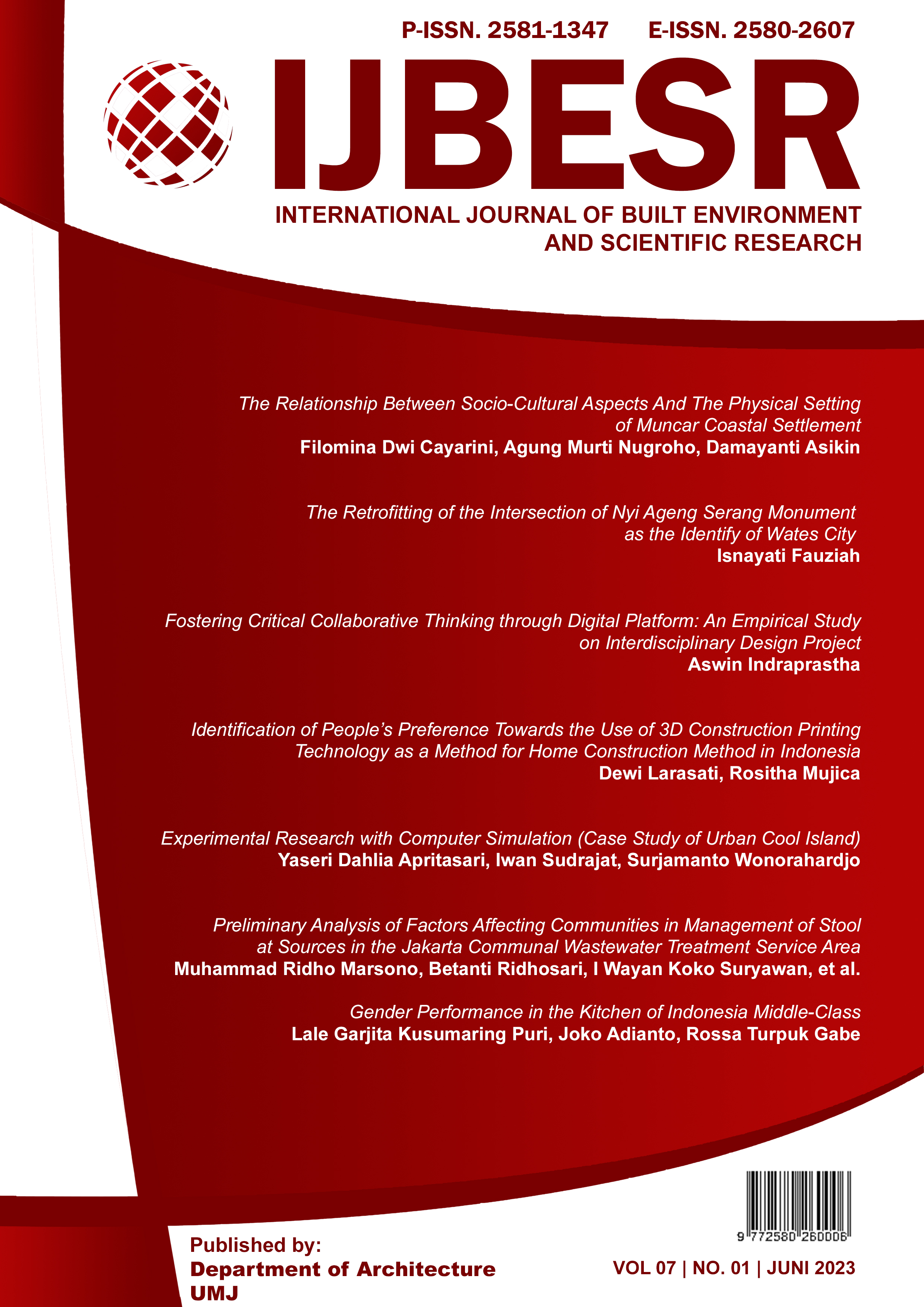Identification of People's Preference Towards the Use of 3D Construction Printing Technology as a Method for Home Construction Method in Indonesia
DOI:
https://doi.org/10.24853/ijbesr.7.1.31-40Kata Kunci:
Preferences, 3D Constrcution Printing, Industry 4.0, Construction, TechnologyAbstrak
Various sectors have undergone changes and developments with the existence of technology. One of the sectors affected by the development of the technology industry is the construction sector. The construction sector is experiencing slow growth compared to other sectors. The construction industry in Indonesia is still influenced by using quite a lot of human labor. One of the technologies in the construction industry is 3D construction printing. This technology is claimed to build houses faster, cheaper, and more efficiently. The community as a market and players from the construction sector take an essential part so that development using this technology becomes right on target, especially in the construction of residential houses for the community. The purpose of this study is to find out people's preferences regarding the existence of 3d construction printing technology for residential construction to open the potential for alternative house construction methods other than conventional methods. The research method is carried out using a qualitative approach. The data collection method uses an open-ended online questionnaire and is distributed freely (non-random sampling). This research also showed what kind of community category that interested in building their home using this technology. The collected data was then analyzed qualitatively through content analysis using the JMP program. The results showed categories of public opinion regarding using 3D construction printing technology as a house construction method, including Impressive, Sustainability, Innovation, Effectiveness, Inexperienced, Usefulness, Efficiency, Complexity, High construction costs, and Quality Test.Furthermore, regarding people's preferences for using 3D Construction Printing to build their homes, 41% said yes, 41% said maybe, and 16% said no. This shows that this technology is mainly accepted by the public but due to a lack of understanding, research, and knowledge, so that many answers as possible. The community category most interested in using this technology to build their homes are people with a monthly income of around 3-6 million rupiah, and the occupation is government employees and entrepreneurs with the same percentage of 0,6 as other occupations below 0,5. The categories are inexperienced and usefulness. The results of this study are expected to be a consideration for stakeholders in building houses using the 3D construction printing method that can be used for residential homes in Indonesia.Referensi
World Economic Forum, Readiness for the Future of Production Report 2018. 2018.
Prime Minister’s Industry 4.0 Taskforce, Industry 4.0 Testlabs in Australia Preparing for the Future. 2017.
N. Labonnote, A. Rønnquist, B. Manum, and P. Rüther, “Additive construction: State-of-the-art, challenges and opportunities,” Autom. Constr., vol. 72, pp. 347–366, Dec. 2016, doi: 10.1016/J.AUTCON.2016.08.026.
J. Lee, I. Cameron, and M. Hassall, “Improving process safety: What roles for Digitalization and Industry 4.0?,” Process Saf. Environ. Prot., vol. 132, pp. 325–339, Dec. 2019, doi: 10.1016/J.PSEP.2019.10.021.
L. Huang, G. Krigsvoll, F. Johansen, Y. Liu, and X. Zhang, “Carbon emission of global construction sector,” Renew. Sustain. Energy Rev., vol. 81, pp. 1906–1916, Jan. 2018, doi: 10.1016/J.RSER.2017.06.001.
dinas pupr, “WEB Pupr.” https://dinaspupr.bandaacehkota.go.id/2020/07/29/pengaruh-revolusi-industri-4-0-terhadap-dunia-konstruksi/.
McKinsey, “MGI-Briefing-Note-Twenty-five-years-of-digitization-May-2019,” pp. 1–12, 2019.
A. N. Hanissaa and B. Paramita, “Sefaira Simulation in Residential Houses to Determine the Energy Use of Wall Materials,” IOP Conf. Ser. Earth Environ. Sci., vol. 738, no. 1, 2021, doi: 10.1088/1755-1315/738/1/012017.
BPS, “Persentase Rumah Tangga yang Memiliki Akses Terhadap Hunian Yang Layak Dan Terjangkau Menurut Daerah Tempat Tinggal (Persen),” Badan Pusat Statistik. 2021, [Online]. Available: https://www.bps.go.id/indikator/indikator/view_data/0000/data/1242/sdgs_11/1.
M. A. Hossain, A. Zhumabekova, S. C. Paul, and J. R. Kim, “A review of 3D printing in construction and its impact on the labor market,” Sustainability (Switzerland), vol. 12, no. 20. MDPI, pp. 1–21, Oct. 02, 2020, doi: 10.3390/su12208492.
N. O. E. Olsson, E. Arica, R. Woods, and J. A. Madrid, “Industry 4.0 in a project context: Introducing 3D printing in construction projects,” Proj. Leadersh. Soc., vol. 2, p. 100033, Dec. 2021, doi: 10.1016/J.PLAS.2021.100033.
A. L. M. Tobi, S. A. Omar, Z. Yehia, S. Al-Ojaili, A. Hashim, and O. Orhan, “Cost viability of 3D printed house in UK,” IOP Conf. Ser. Mater. Sci. Eng., vol. 319, no. 1, 2018, doi: 10.1088/1757-899X/319/1/012061.
I. Hager, A. Golonka, and R. Putanowicz, “3D Printing of Buildings and Building Components as the Future of Sustainable Construction?,” Procedia Eng., vol. 151, no. August, pp. 292–299, 2016, doi: 10.1016/j.proeng.2016.07.357.
dinas pupr, “Program Sejuta Rumah Kementrian PUPR,” 2021. https://perumahan.pu.go.id/news/2021-program-sejuta-rumah-tetap-dilanjutkan-dorong-program-sejuta-rumah-kementerian-pupr-siapkan-kebijakan-dan-strategi-khusus.
M. G. Gunagama and N. F. Lathifa, “Automatictecture : Otomatisasi Penuh Dalam Arsitektur Masa Depan,” NALARs, vol. 16, no. 1, p. 43, 2017, doi: 10.24853/nalars.16.1.43-60.
M. Mohammad, E. Masad, and S. G. Al-Ghamdi, “3d concrete printing sustainability: A comparative life cycle assessment of four construction method scenarios,” Buildings, vol. 10, no. 12, pp. 1–20, 2020, doi: 10.3390/buildings10120245.
J. W. Cresswell, “Qualitative inquiry and research design: Choosing among five approaches (3rd ed.),” Sage, 2007.
R. García-Alvarado, G. Moroni-Orellana, and P. Banda-Pérez, “Architectural evaluation of 3d-printed buildings,” Buildings, vol. 11, no. 6, pp. 1–19, 2021, doi: 10.3390/buildings11060254.
M. Sakin and Y. C. Kiroglu, “3D Printing of Buildings: Construction of the Sustainable Houses of the Future by BIM,” Energy Procedia, vol. 134, pp. 702–711, 2017, doi: 10.1016/j.egypro.2017.09.562.
M. Batikha, R. Jotangia, M. Y. Baaj, and I. Mousleh, “3D concrete printing for sustainable and economical construction: A comparative study,” Autom. Constr., vol. 134, no. November 2021, p. 104087, 2022, doi: 10.1016/j.autcon.2021.104087.
Kumar, Ranjit. 2005. Research Methodology: astep by step guide for beginners. Londong : sage







